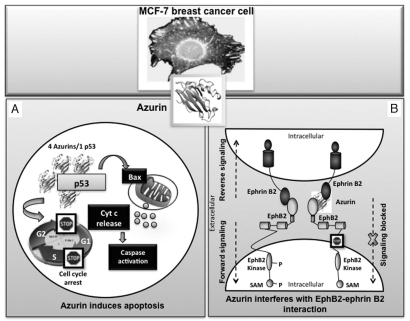Figure 1.
The mode of action of azurin in the induction of apoptosis and growth inhibition of a MCF-7 breast cancer cell is shown schematically. Azurin can enter the cancer cell to form a complex with tumor suppressor protein p53 (4 azurin molecules per 1 p53 molecule), stabilizing it and enhancing its intracellular level, which leads to apoptosis via caspase-mediated mitochondrial cytochrome c release pathways (A). Azurin can also bind avidly to the surface—exposed receptor tyrosine kinase EphB2, interfering in its binding with the ligand ephrinB2, and thereby preventing cell signaling that promotes cancer cell growth (B).

